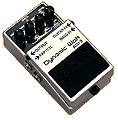Effects Pedals: What order do they go in?
Basic guidelines to link your chain of effects pedals will minimize noise
and hiss while making each effect work to its potential. Start here:
- First, plug your guitar into dynamic effects such as a
compressor
and limiter to
give the rest of the effects a smooth, even signal.
- If you want the equalizer to have the greatest effect, it
should follow the compressor. Equalizers can be used at a variety of stages depending on what effect
you want to equalize. They can be helpful at the end of the chain
to adjust your overall sound or in the middle to enhance a particular effect,
such as a distortion pedal.
- Next in line are your distortions, overdrive, fuzz boxes, etc.,
because you want to put high-gain devices on a clean signal, not a
processed one.
- Next, add your "time" effects such as
chorus, flanger, phase shifter, tremolo, and pitch shift effects
such as octave, etc. The order doesn't matter that much.
- Place delay and reverb effects last in the chain (closest to the input of your amplifier).
This way you can have the chorus or flanging effects on repeats, and
you can hear your active effects in the decaying reverb. Also, if a reverb or delay effect gets "processed"
through distortion or time effects, they tend to get muddy
and undefined.

-
 "Tone" devices such as
wah can be placed before or
after distortion pedals depending on your desired effect. It is
common to place the wah first in the chain. That way, whatever is
going on after the wah will be affected by the tonal variations
it produces. It can produce some very cool and intense
effects when placed last, as well.
"Tone" devices such as
wah can be placed before or
after distortion pedals depending on your desired effect. It is
common to place the wah first in the chain. That way, whatever is
going on after the wah will be affected by the tonal variations
it produces. It can produce some very cool and intense
effects when placed last, as well.
But don't live by the "rules!" Experiment and build your
own
sound! You can't break anything, so plug it in and see how it sounds. Even if you have two or three pedals, spend some time playing
around with their placement until you find what sounds good to your
ears. Some of the most accomplished players have found
unique and interesting sounds by breaking the rules. |
